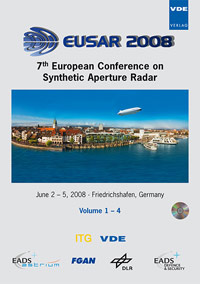Advanced Onboard Technologies for ISRO’s RISAT-I Follow-on L-Band Polarimetric SAR Mission
Conference: EUSAR 2008 - 7th European Conference on Synthetic Aperture Radar
06/02/2008 - 06/05/2008 at Friedrichshafen, Germany
Proceedings: EUSAR 2008
Pages: 4Language: englishTyp: PDF
Personal VDE Members are entitled to a 10% discount on this title
Authors:
Desai, Nilesh M.; Vachhani, J. G.; Kumar, B. Saravana; Gujraty, V. R. (MSDPD/MSDG/MRSA/SAC, RISAT Building No. 52, Space Applications Centre (SAC), Ambawadi Vistar P.O, Indian Space Research Organisation (ISRO), Ahmedabad-380 015. India)
Abstract:
Since 1985, ISRO/India has been working on Synthetic Aperture Radar (SAR) technologies under its Microwave Remote Sensing Programme (MRSP). During these years, ISRO has already developed and operationalised two airborne C-band imaging SAR systems. Thereafter, RISAT-1 multi-mode spaceborne SAR development has been initiated. Various onboard base-band subsystems and Tile Electronics of RISAT-1, scheduled for launch in 2008/2009 timeframe are in advanced stages of development. For the next decade, ISRO has also planned a number of future SAR missions in LEO orbits like L-band Polarimetric SAR, P- and X-Band Agile Airborne and Small Satellite SARs. The major subsystems of all these future microwave missions will also be based on Core Radar electronics developed for RISAT-1. Considering the obvious advantages offered by L-band microwave remote sensing for Agriculture applications and India being predominantly agriculture based economy, ISRO has identified L-band Polarimetric SAR mission as the main follow-on mission of RISAT-1. The basic design requirements for this L-band SAR mission are 30- 240 km swath coverage with moderate 5-25 meter resolution, Stripmap and ScanSAR operating modes with polarimetric capability. The design and development of various advanced technology elements like active antenna consisting of about 80 miniaturized Transmit/Receive modules with associated controls and onboard base-band Digital Subsystems like Data Acquisition and Compression system (DACS), Digital Chirp Generator (DCG), Distributed Embedded Controller consisting of Payload Controller (PLC), Tile Control Units (TCU) and TR Control (TRC) units, have been initiated. This apart, RISAT-1 Ground segment consisting of Real / Near Real Time Quick Look SAR Processor (QLP) and Ground Checkout Units (GCU) will also be augmented and utilized for this L-band SAR mission. This paper gives the details of design requirements of L-band Polarimetric SAR, tradeoffs, salient features, implementation details and preliminary test results of the various advanced onboard technology elements for L-band multi-mode Polarimetric SAR payload for ISRO’s RISAT-1 follow-on satellite mission.


